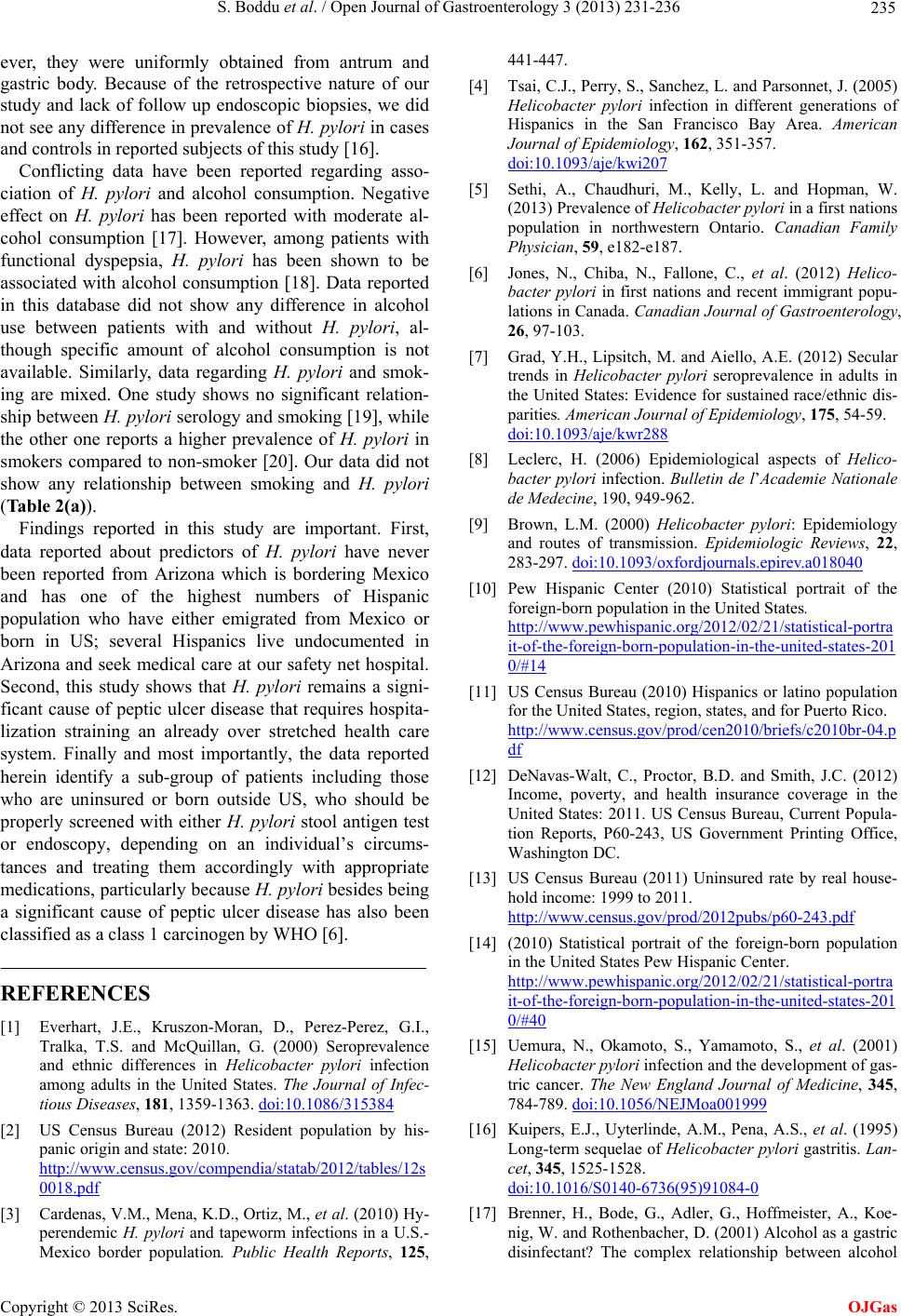
S. Boddu et al. / Open Journal of Gastroenterology 3 (2013) 231-236 235
ever, they were uniformly obtained from antrum and
gastric body. Because of the retrospective nature of our
study and lack of follow up endoscopic biopsies, we did
not see any difference in prevalence of H. pylori in cases
and controls in reported subjects of this study [16].
Conflicting data have been reported regarding asso-
ciation of H. pylori and alcohol consumption. Negative
effect on H. pylori has been reported with moderate al-
cohol consumption [17]. However, among patients with
functional dyspepsia, H. pylori has been shown to be
associated with alcohol consumption [18]. Data reported
in this database did not show any difference in alcohol
use between patients with and without H. pylori, al-
though specific amount of alcohol consumption is not
available. Similarly, data regarding H. pylori and smok-
ing are mixed. One study shows no significant relation-
ship between H. pylori serology and smoking [19], while
the other one reports a higher prevalence of H. pylori in
smokers compared to non-smoker [20]. Our data did not
show any relationship between smoking and H. pylori
(Table 2(a)).
Findings reported in this study are important. First,
data reported about predictors of H. pylori have never
been reported from Arizona which is bordering Mexico
and has one of the highest numbers of Hispanic
population who have either emigrated from Mexico or
born in US; several Hispanics live undocumented in
Arizona and seek medical care at our safety net hospital.
Second, this study shows that H. pylori remains a signi-
ficant cause of peptic ulcer disease that requires hospita-
lization straining an already over stretched health care
system. Finally and most importantly, the data reported
herein identify a sub-group of patients including those
who are uninsured or born outside US, who should be
properly screened with either H. pylori stool antigen test
or endoscopy, depending on an individual’s circums-
tances and treating them accordingly with appropriate
medications, particularly because H. pylori besides being
a significant cause of peptic ulcer disease has also been
classified as a class 1 carcinogen by WHO [6].
REFERENCES
[1] Everhart, J.E., Kruszon-Moran, D., Perez-Perez, G.I.,
Tralka, T.S. and McQuillan, G. (2000) Seroprevalence
and ethnic differences in Helicobacter pylori infection
among adults in the United States. The Journal of Infec-
tious Diseases, 181, 1359-1363. doi:10.1086/315384
[2] US Census Bureau (2012) Resident population by his-
panic origin and state: 2010.
http://www.census.gov/compendia/statab/2012/tables/12s
0018.pdf
[3] Cardenas, V.M., Mena, K.D., Ortiz, M., et al. (2010) Hy-
perendemic H. pylori and tapeworm infections in a U.S.-
Mexico border population. Public Health Reports, 125,
441-447.
[4] Tsai, C.J., Perry, S., Sanchez, L. and Parsonnet, J. (2005)
Helicobacter pylori infection in different generations of
Hispanics in the San Francisco Bay Area. American
Journal of Epidemiology, 162, 351-357.
doi:10.1093/aje/kwi207
[5] Sethi, A., Chaudhuri, M., Kelly, L. and Hopman, W.
(2013) Prevalence of Helicobacter pylori in a first nations
population in northwestern Ontario. Canadian Family
Physician, 59, e182-e187.
[6] Jones, N., Chiba, N., Fallone, C., et al. (2012) Helico-
bacter pylori in first nations and recent immigrant popu-
lations in Canada. Canadian Journal of Gastroenterology,
26, 97-103.
[7] Grad, Y.H., Lipsitch, M. and Aiello, A.E. (2012) Secular
trends in Helicobacter pylori seroprevalence in adults in
the United States: Evidence for sustained race/ethnic dis-
parities. American Journal of Epidemiology, 175, 54-59.
doi:10.1093/aje/kwr288
[8] Leclerc, H. (2006) Epidemiological aspects of Helico-
bacter pylori infection. Bulletin de l’Academie Nationale
de Medecine, 190, 949-962.
[9] Brown, L.M. (2000) Helicobacter pylori: Epidemiology
and routes of transmission. Epidemiologic Reviews, 22,
283-297. doi:10.1093/oxfordjournals.epirev.a018040
[10] Pew Hispanic Center (2010) Statistical portrait of the
foreign-born population in the United States.
http://www.pewhispanic.org/2012/02/21/statistical-portra
it-of-the-foreign-born-population-in-the-united-states-201
0/#14
[11] US Census Bureau (2010) Hispanics or latino population
for the United States, region, states, and for Puerto Rico.
http://www.census.gov/prod/cen2010/briefs/c2010br-04.p
df
[12] DeNavas-Walt, C., Proctor, B.D. and Smith, J.C. (2012)
Income, poverty, and health insurance coverage in the
United States: 2011. US Census Bureau, Current Popula-
tion Reports, P60-243, US Government Printing Office,
Washington DC.
[13] US Census Bureau (2011) Uninsured rate by real house-
hold income: 1999 to 2011.
http://www.census.gov/prod/2012pubs/p60-243.pdf
[14] (2010) Statistical portrait of the foreign-born population
in the United States Pew Hispanic Center.
http://www.pewhispanic.org/2012/02/21/statistical-portra
it-of-the-foreign-born-population-in-the-united-states-201
0/#40
[15] Uemura, N., Okamoto, S., Yamamoto, S., et al. (2001)
Helicobacter pylori infection and the development of gas-
tric cancer. The New England Journal of Medicine, 345,
784-789. doi:10.1056/NEJMoa001999
[16] Kuipers, E.J., Uyterlinde, A.M., Pena, A.S., et al. (1995)
Long-term sequelae of Helicobacter pylori gastritis. Lan-
cet, 345, 1525-1528.
doi:10.1016/S0140-6736(95)91084-0
[17] Brenner, H., Bode, G., Adler, G., Hoffmeister, A., Koe-
nig, W. and Rothenbacher, D. (2001) Alcohol as a gastric
disinfectant? The complex relationship between alcohol
Copyright © 2013 SciRes. OJGas